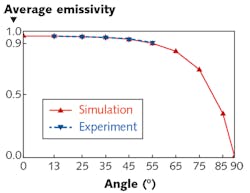Simple, angle-independent radiative surface could passively cool buildings
The Earth is surrounded by a vast heat sink: the Universe, which at a temperature of 3 K, can enable significant cooling of surfaces on Earth via electromagnetic radiation in the 8–13 µm wavelength atmospheric transmission region (which also happens to contain the peak emission wavelength of a blackbody at room temperature). For possible use in cooling buildings, various forms of micro- and nanoscopically featured surface structures have been developed with the aim of maximizing emissivity across this entire atmospheric window. The types of structure developed have been complicated to make—for example, involving multiple steps of electron-beam lithography or nanoimprint lithography and reactive ion etching. Now, researchers at Zhejiang University (Hangzhou, China) have come up with a simple and low-cost radiative cooling surface formed by a one-dimensional (1D) photonic crystal. “1D photonic crystal” is another term for a structure consisting of differing flat layers of optically useful thin-film material placed on top of one another. Thus, these structures are relatively easy to fabricate over very large areas by simple deposition.
Fabricated on silica (SiO2), the experimental structure consists of a 730 nm film of titanium dioxide (TiO2), an 800 nm film of SiO2, an 800 nm film of TiO2, an 800 nm film of SiO2, a 230 nm film of SiO2, and a 175 nm film of zinc sulfide (ZnS). The simulated and experimental angular average emissivity of the 1D photonic crystal radiative cooler for the 8–13 µm atmospheric transmission window agree well, and in addition show that the emissivity remains high over a very large angular range. The researchers say that the maximum cooling power density of the fabricated radiative cooler experimentally reached 113.0 W/m2 at night. When integrated with a solar reflector that reflects 97% of incident solar power, the radiative cooler could theoretically radiate 83.0 W/m2 away to space, even while being irradiated by sunlight at up to 1000 W/m2 at noon. Reference: H. Yuan et al., Opt. Express (2018); https://doi.org/10.1364/oe.26.027885.
About the Author
John Wallace
Senior Technical Editor (1998-2022)
John Wallace was with Laser Focus World for nearly 25 years, retiring in late June 2022. He obtained a bachelor's degree in mechanical engineering and physics at Rutgers University and a master's in optical engineering at the University of Rochester. Before becoming an editor, John worked as an engineer at RCA, Exxon, Eastman Kodak, and GCA Corporation.

